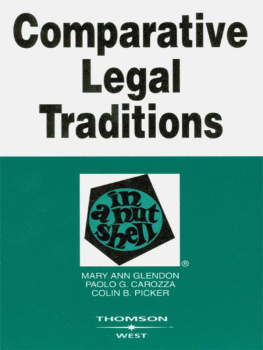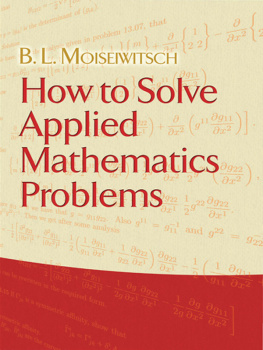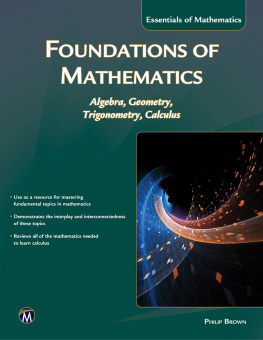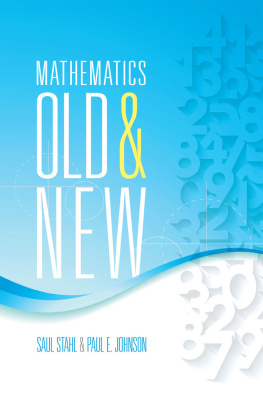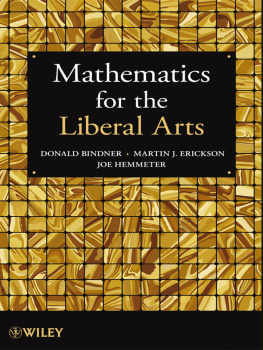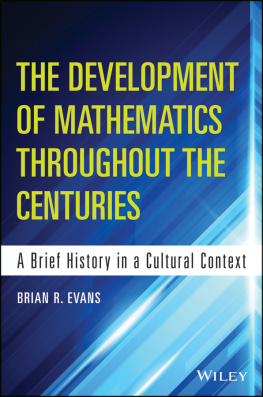Landmarks
Page list

WESTS LAW SCHOOL
ADVISORY BOARD
_________
JESSE H. CHOPER
Professor of Law,
University of California, Berkeley
JOSHUA DRESSLER
Professor of Law, Michael E. Moritz College of Law,
The Ohio State University
YALE KAMISAR
Professor of Law, University of San Diego
Professor of Law, University of Michigan
MARY KAY KANE
Professor of Law, Chancellor and Dean Emeritus,
University of California,
Hastings College of the Law
LARRY D. KRAMER
Dean and Professor of Law, Stanford Law School
JONATHAN R. MACEY
Professor of Law, Yale Law School
ARTHUR R. MILLER
University Professor, New York University
Professor of Law Emeritus, Harvard University
GRANT S. NELSON
Professor of Law, Pepperdine University
Professor of Law Emeritus, University of California, Los Angeles
A. BENJAMIN SPENCER
Associate Professor of Law,
Washington & Lee University School of Law
JAMES J. WHITE
Professor of Law, University of Michigan
I
COMPARATIVE LEGAL TRADITIONS
IN A NUTSHELL
THIRD EDITION
By
MARY ANN GLENDON
Learned Hand Professor of Law
Harvard Law School
PAOLO G. CAROZZA
Associate Professor of Law
Notre Dame Law School
COLIN B. PICKER
Daniel L. Brenner/UMKC Scholar &
Professor of Law
University of MissouriKansas City School of Law

Mat #40639018
II
Thomson/West have created this publication to provide you with accurate and authoritative information concerning the subject matter covered. However, this publication was not necessarily prepared by persons licensed to practice law in a particular jurisdiction. Thomson/West are not engaged in rendering legal or other professional advice, and this publication is not a substitute for the advice of an attorney. If you require legal or other expert advice, you should seek the services of a competent attorney or other professional.
Nutshell Series, In a Nutshell , the Nutshell Logo and West Group are trademarks registered in the U.S. Patent and Trademark Office.
COPYRIGHT 1982 WEST PUBLISHING CO.
West, a Thomson business, 1999
2008 Thomson/West
610 Opperman Drive
St. Paul, MN 55123
18003139378
Printed in the United States of America
ISBN: 9780314184283

IX
COMPARATIVE LEGAL TRADITIONS
IN A NUTSHELL
THIRD EDITION
*
III
OUTLINE
___________
Sec.
Sec.
IV
Sec.
Sec.
Sec.
Sec.
V
Sec.
Sec.
VI
Sec.
VII
Sec.
Sec.
Sec.
VIII
Sec.
Sec.
INTRODUCTION TO THE COMPARATIVE STUDY OF LAW
1. What Is Comparative Law?
When the first learned societies dealing with cross-national legal comparisons were established in France, Germany, and England in the late nineteenth century, their founders took for granted that comparative methods would advance the understanding of a broad range of legal issues. In that expectation, legal scholars were in accord with the best of their counterparts in other disciplines. Emile Durkheim had gone so far as to claim that, Comparative sociology is not a particular branch of sociology; it is sociology itself. The great legal historian F.W. Maitland had insisted that, The English lawyer who knew nothing and cared nothing for any system but his own, hardly came in sight of the idea of legal history.
The question arises, however: Why, if the benefits of comparative studies are so substantial and obvious, did comparative law remain a relative backwater in twentieth century American legal education? No doubt there are several reasons, not least of which is the increasing burden of keeping up with developments in our own legal system, perhaps one of the most complex the world has ever known. To achieve even minimal competence in another countrys legal system requires a major expenditure of time and effort, including, in many cases, learning another language. But, perhaps the main reason is probably that Americans have long tended to assume that they could get along quite well without casting their gaze beyond national borders. Like Roman jurists of old, many U.S. lawyers were convinced of the self-sufficiency of their legal and political arrangements.
In recent years, however, that insular posture has become untenable. With unprecedented global interdependence, and with commerce and instant communication linking all regions of the earth, nearly every legal field has acquired an international dimension. We live in a world where national boundaries are of diminishing significance in relation to technology, finance, trade, the environment, information, consumerism, entertainment, the arts, and ideas of universal human rights. Legal education, accordingly, has had to adjust to demands for the skills required by lawyers in the global village. As the twenty-first century dawns, international legal studies are burgeoning to a degree that early comparatists could scarcely have imagined. Yet, as Basil Markesinis has written, comparative law is still searching for an audience even where it has found a place of sorts in the university curriculum.
In the years to come, it is likely that comparative law will find many different sorts of audiences as it takes its rightful place among the methods required for the effective study and practice of law. Certain fields have always had a comparative dimension: conflict of laws, international business law, public international law, and area studies where the object is to become familiar with a particular foreign legal system. In those fields, cross-national studies are now assuming greater importance than ever. Contracts and commercial law teachers are having to spend an increasingly large proportion of course time on the international aspects of their subjects if they wish to keep pace with developments in the practice. Increasingly, law professors in many other fields are moving in the direction counseled by Roscoe Pound in the 1930sexploring the approaches of other legal systems to the issues that arise in the course of teaching the law of the land. The increasing importance of supranational law will present new challenges for comparatists as the roles of nation states and national law undergo transformation.
2. Aims and Uses of Comparative Law
It is fair to say that comparative law, as befits a developing field, is experiencing something of an identity crisis. The existence of lively debate concerning aims and methods, however, has not hindered comparatists from happily pursuing cross-national studies in a variety of ways and for a wide range of purposes. Nor has it prevented those studies from yielding important contributions to the understanding, practice, and reform of contemporary law. In all likelihood, the diversity of aims and methods among comparatists promotes the vitality of their work. In a world where national and cultural differences are often seen as posing a formidable challenge, comparatists hold up a view of diversity as an invitation, an opportunity, and a crucible of creativity. In a heterogeneous nation like the United States where empathetic understanding among groups often seems elusive, comparatists are witnesses to the joys and discoveries awaiting those who make the effort to enter imaginatively into another mental framework.

